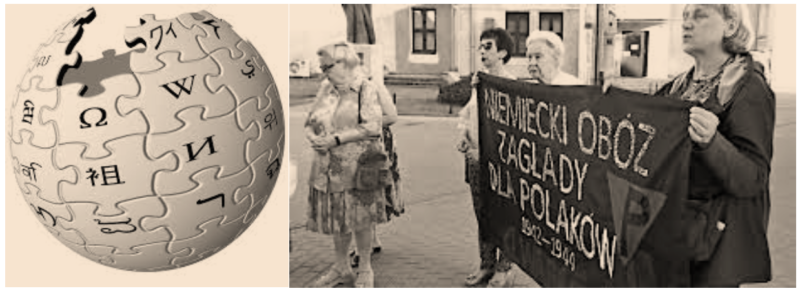I was stunned and appalled to encounter yet another new version of a negationist account, which has been disseminated for an extended period as a piece of innocent information, based on academic and scientific sources: the Wikipedia.
I became aware of this startling news from an article in the Israeli daily newspaper, Ha’aretz on October 4th.
Guy Briole introduced the concept of “gray discourse”, which recently in an interview he defined concisely as, “[…] cet effet d’un usage de la parole et de la rhétorique qui déforme la pensée où les enjeux touchant à ce que l’Histoire a établi et aux témoignages des survivants des camps, d’autant plus que, le temps passant, ils quittent ce monde — ne peut que proliférer.”[1]. In other words, it us a spoken and rhetoric use of language, which distorts the way of thinking about various historical events it has established by basing it on testimonies about these events. Only in this case it is not about the denial of events that had occurred but describing events that never had happened: Extermination of the Poles – a “Polocaust”, a metonymy combining “Poles” with “Holocaust”. This is a concept recognized by the Polish academy, which aims at creating an equivalence between the Poles and the Jews regarding the extermination. Can we talk of a hallucinatory phenomenon? In such case we are dealing with a “fabricated discourse”, seeking to create for the polish people the image of the victim, and to delete any remnant its cooperation with the Nazi regime.
This information prompted the erection of a monument on the site, which in turn brought about public remembrance ceremonies commemorating these Polish victims.
Over many years and in different languages, this Wikipedia article claimed that 200,000 Poles were gassed in KL Warsaw concentration camp, which indeed existed in Warsaw itself, built on the ruins of the Jewish Warsaw Ghetto.
In fact, there were no gas chambers there. Prof. Jan Grabowsky, a Polish-Canadian historian, among others, like Prof. Havi Dreifus of Yad Vashem and Tel Aviv University present this “extermination” as “fake history”. The camp was a cluster of incarceration stations, related to the Warsaw Ghetto uprising (1943) and the Polish rebellion (1944).
Jews from Hungary, Italy and Greece were deported to this concentration camp, which operated as such till 1944. On the one hand, the publication of this article in the Encyclopedia is no surprise, but on the other, nationalistic editors working for Wikipedia clothed the skeletal fact of the camp’s existence with false events.
The basis for the “conspiracy theory” was Maria Trzcinska’s 2002 book Oboz Zaglady W Centrum Warszawy KL-Warschau. She was a judge who worked for thirty years in the Committee for the Investigation of Nazi Crimes in Poland. Certain details of the book, like the alleged existence of gas chambers in this camp, are based on rumors, which were refuted in 2007. Despite this to this day, her arguments gain a constantly growing number of adherents.
It should take into account that the Polish government has recently instated a law, which prohibits holding the Polish People or State responsible of complicity to Nazi crimes.
In the last few weeks the Wikipedia article was rewritten and the fabricated events were removed. But the polemic between the polish and other editors continues.
Wikipedia’s arbitration committee views this distorted information as an error but does not allow non-Polish editors to rewrite articles pertaining to Poland and the Holocaust.
Wiki-Weaki-pedia indeed allows and encourages distortions of history based on academic work, which fabricates them in service of raising high the flag of ultra-nationalism. Interestingly, this thought vector, which strives to fabricate an extermination that never happened, gas chambers that were never installed and erect a monument to commemorate an event, which never took place, creates a victimology fitting what Lacan pointed out: “the presence of the desire of this Other that I call here the dark God“[2]. Who is, in this case, the dark God? What kind of Amor intellectualis is involved? To be or not to be believed…
[1] Guy Briole, Rivages, Annoce du Colloque de la ACF-ECA, “Ségrégations, haines et désire de l’analyste”
[2] J.Lacan, The four fundamental concepts of psycho-analysis, Penguin books, page 275

